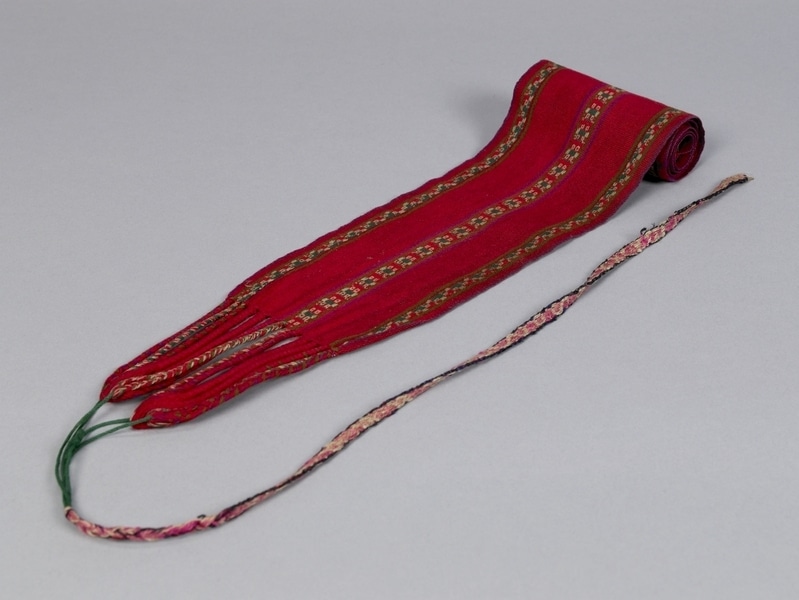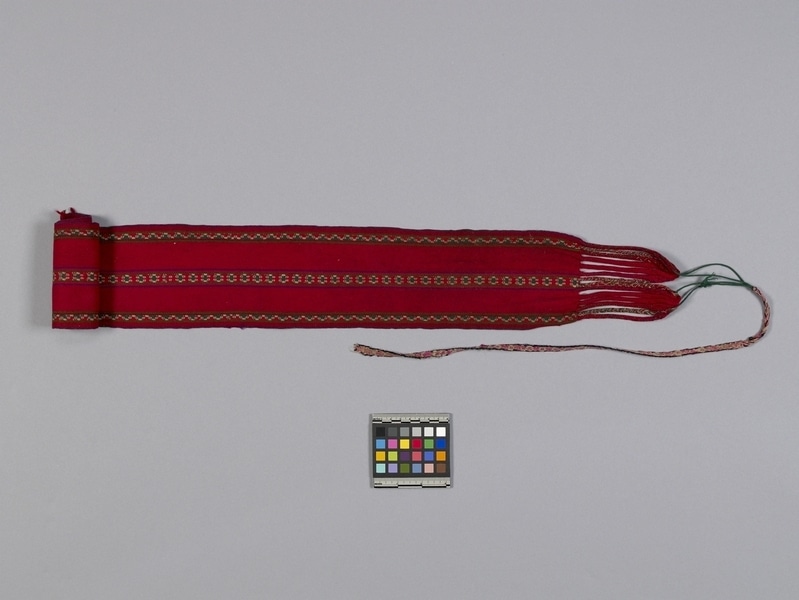Belt Item Number: Sf1008 from the MOA: University of British Columbia


Description
Wide red belt with three lengthwise patterned stripes. Outer bands are stepped triangle shapes with white squares, center motif are white squares around green rectangles. Purple stripes flank center band, and also run along edges. One end of band terminates in fourteen braids which are looped on a green cord knotted to a narrow woven band. Woven ties has pink diagonal stripes on white.
History Of Use
Warp-faced fabric with three or four selvedges are woven by women but the fabrics are used by both sexes. The techniques, structures and some of the motifs have pre-Conquest antecedents. This type of textile conveys the most information about an individual's ethnicity, sex, age, status and particular history. Wide red belts are worn by most adults for everyday wear and special occasions. Most have a variety of figurative and geometric motifs, particularly in the central band. This belt is unusual in having only repetitive patterns which are usually confined to subsidiary positions on more elaborate belts. The patterning of this belt is similar to the patterning on older Taquile textiles.
Specific Techniques
Commercial synthetic yarns, z spun and plied 2 s, are retwisted before warping. The stripes and background are warp-faced plain weave. The pattern bands are a float weave derived from a turned 2/1 horizontal herringbone. The fabric is woven to size on a continuous warp and the terminal area is braided in 3 strand oblique interlacing. A replied cord is looped through the braids and knotted to a separately woven band. The band is a warp-faced complementary warp weave.
Iconographic Meaning
Hatun cruz (large or southern cross); central band motif. Faedma (architectural ruins); stepped triangle motif on side bands.
Narrative
Bought from the maker in her house in Taquile. She was wearing it at the time it was offered for sale. She made it about 8 years ago for her own use. Since Maria's eyesight has deteriorated, she does not weave the figurative designs that many younger women still weave. Maria knows how to weave fabrics and patterns that were popular 65 years ago, when she was a girl. The patterns on this belt are like those found on cloths, in the Museo Artesanal, in Taquile, from 50-75 years ago. Maria taught the collector and some Taquile weavers how to make c'elco, a woven band that was used formerly to edge women's carrying cloths.
Item History
- Made by Maria Huatta Charka (Maker) in Taquile, Puno, Peru during 1979
- Collected by Mary Frame during 1987
- Owned by Maria Huatta Charka
- Owned by Mary Frame before November 3, 1987
- Received from Mary Frame (Seller) and Museum of Anthropology Shop Volunteers (Funding source) on November 3, 1987
What
Who
- Culture
- Quechua
- Creator
- Maria Huatta Charka (Maker)
- Field Collector
- Mary Frame
- Previous Owner
- Maria Huatta Charka and Mary Frame
- Received from
- Mary Frame (Seller) and Museum of Anthropology Shop Volunteers (Funding source)
Where
- Holding Institution
- MOA: University of British Columbia
- Made in
- Taquile, Puno, Peru
When
- Creation Date
- during 1979
- Collection Date
- during 1987
- Ownership Date
- before November 3, 1987
- Acquisition Date
- on November 3, 1987
Other
- Item Classes
- textiles
- Condition
- good
- Accession Number
- 1274/0008